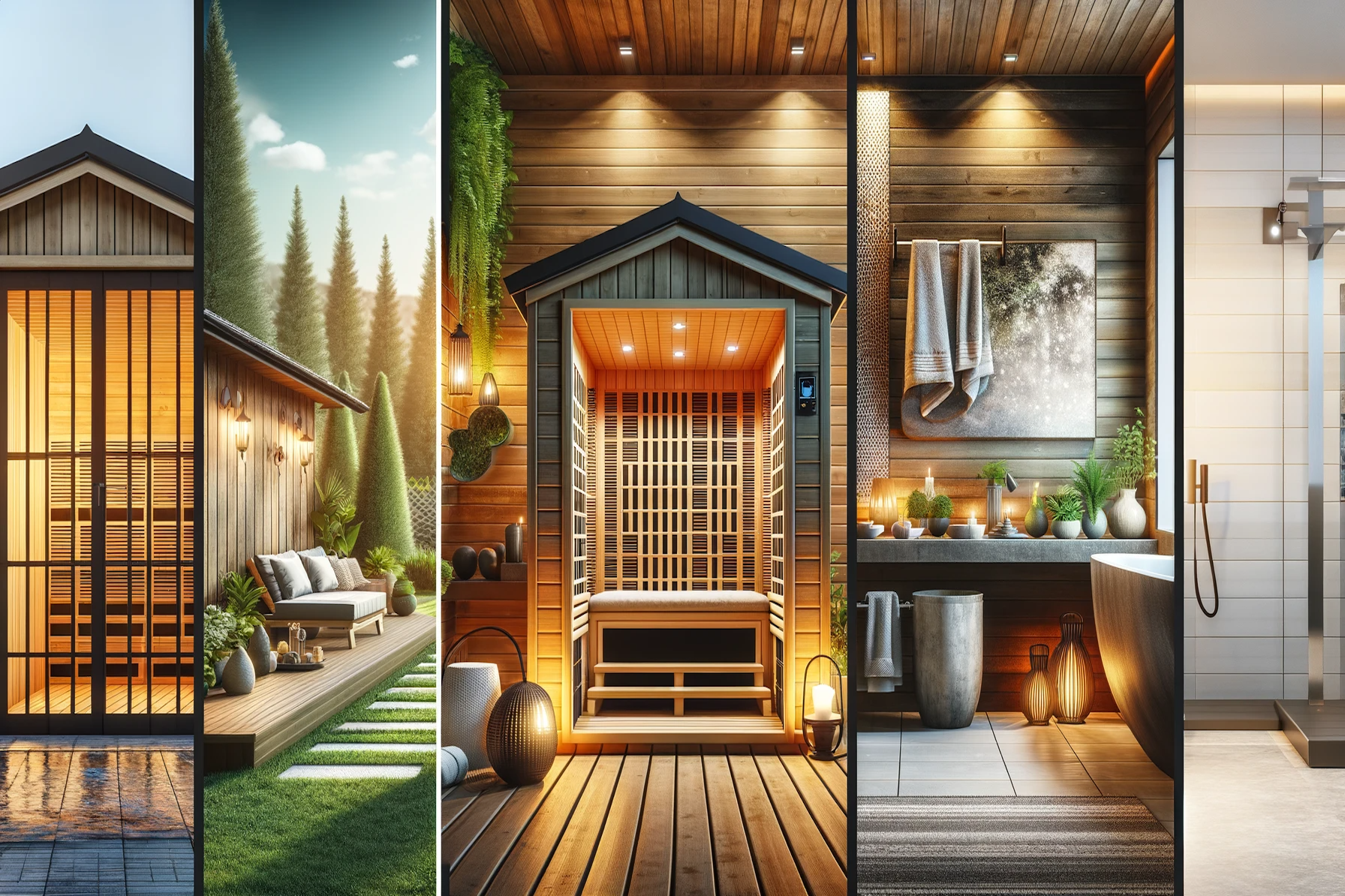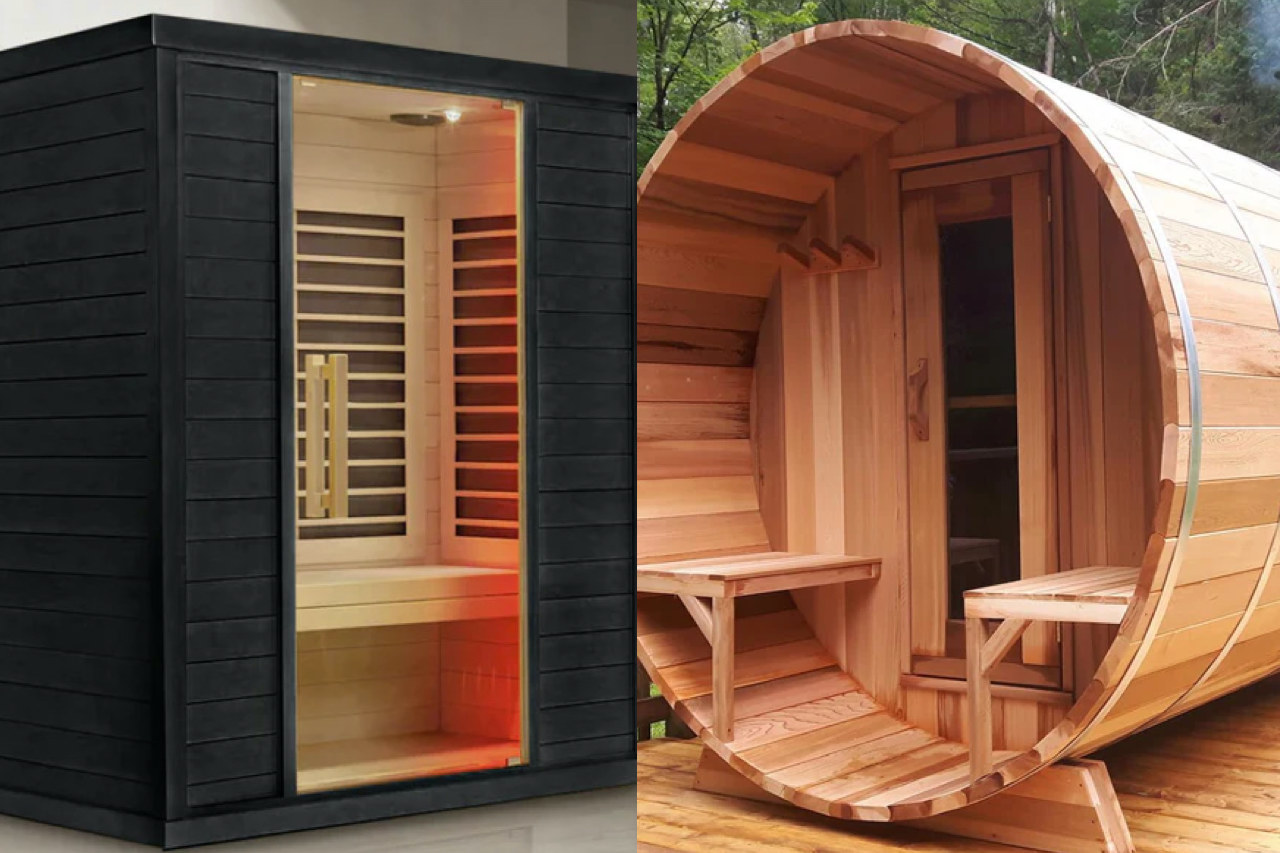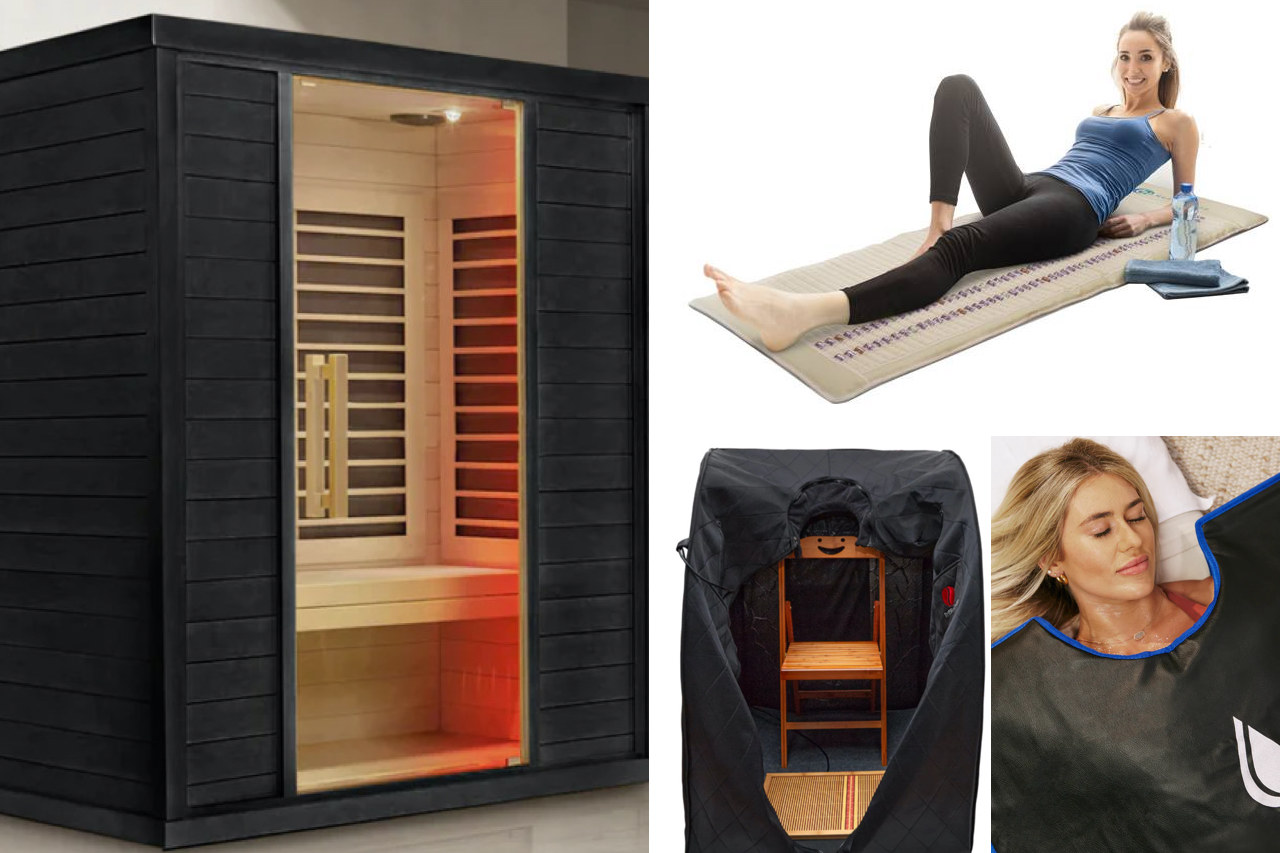- HOME
- Infrared Sauna Insights
- Best Wood For Infrared Sauna
What Is The Best Wood For My Infrared Sauna?

Wondering what might be the best wood for your new home infrared sauna, the following question comes to mind: What is the purpose of wooden sauna cabins? To answer this, we have to go back to the traditional sauna.
For a quick tour by type of wood
- CEDAR
Wood's Role in Traditional Saunas
Functionality: Saunas have long relied on wood, particularly softwood, for its flexibility, moisture resistance, and excellent insulation. Originating from Finnish wooden huts, this obvious choice blends practicality and tradition. Softwood like cedar stands out, as it resists wet conditions, mold, and insects, and guarantees your sauna lasts.
Comfort: Traditional saunas are wooden havens where heated stones create a dry heat. Wood absorbs and releases moisture, balances humidity and prevents condensation damage. Marrying durability to comfort makes sauna sessions a delight.
A Sensory Journey: Wooden saunas function well, and feel and smell great. Wood stays cooler than stone- a comfortable touch. For example, with cedar, you get a natural, soothing aroma that enhances the heat with every session, turning your sauna into a multisensory retreat.
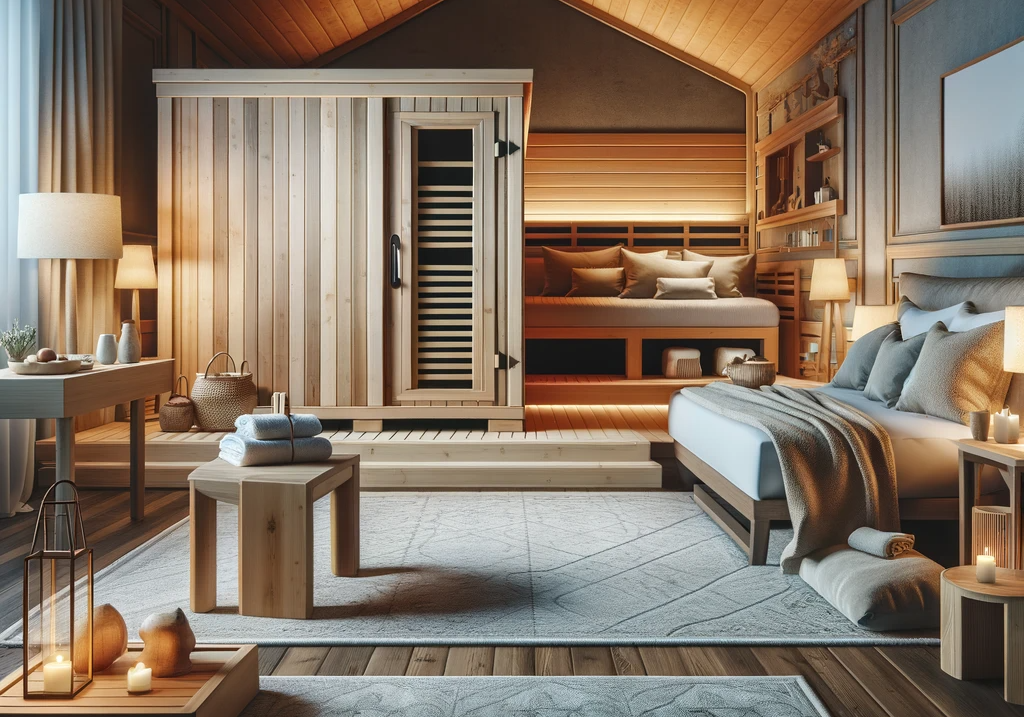
Looking for a new sauna design? Click here for 10 inspiring ideas
The Role of Wood in Infrared Saunas
Why Choose Wood? Wood stands out as the top choice for infrared saunas for many reasons. As a natural insulator, it keeps the heat steady and enjoyable, while it contributes to energy efficiency. It doesn't overheat like metal, ensuring a pleasant stay.
Woods like cedar also have hypoallergenic properties, perfect for sensitive users. Tapping into aromatherapy benefits, cedar’s aroma deepens relaxation as well.
Insulation and Comfort: In infrared saunas, wood helps to maintain a stable temperature. Infrared heat deeply penetrates your body, boosting the sauna’s healing and efficiency capacities. Wood prevents the interior from getting too hot and manages humidity. This makes sessions even more comfortable and prevents damage.
Aesthetic and Tranquility: Wood brings a calming, natural beauty to saunas, adding to the overall experience. Each type, from cedar's rich tones to basswood's lighter hues, creates a unique, peaceful ambiance.
Health and Safety: Wood offers health benefits, too. It naturally combats bacteria and mold, crucial in the warm sauna environment. Cedar repels insects and prevents fungal growth, keeping the space clean. If you have allergies, both cedar and basswood deliver hypoallergenic, irritation-free sauna sessions.
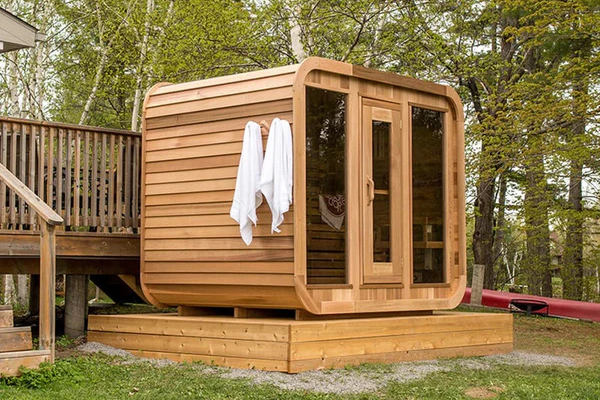
Sun Home Saunas - Their Muskoka Outdoor Cube Sauna is crafted from premium cedar
The Healing Aroma of Wood
To select the best wood for a sauna contributes to a more than satisfying atmosphere and to omroved physical and mental health.
Trees and plants emit odors to defend themselves against harmful germs and insects. These are called phytoncides [1]. When inhaled by humans, these natural essences have been shown to provide significant health benefits.
Wood types such as cedar and spruce bolster the sauna’s healing benefits. These woods are among the largest producers of phytoncides. When heated, the wood releases these beneficial compounds for us to inhale, replicating the healthy environment of a natural forest.
A Speed Date in the Woods
Aspen

Aspen, known as Populus Tremula, is cherished in sauna construction for its light tone, smooth texture, and non-resinous nature. Aspen has the largest natural range of any native tree in North America. This makes aspen wood very accessible. The wood is favored in Scandinavia for the durability and aesthetic appeal that make it an almost standard choice, providing a tranquil, clean ambiance ideal for infrared saunas.
Durability: Aspen wood, known for its longevity, is a durable choice for sauna construction. It resists wear and tear well, retaining its appearance and structure over time. Despite its sensitivity to water, aspen's stability in controlled environments like infrared saunas is notable, as it maintains its shape and does not easily warp or shrink. It is a reliable, long-lasting option, and ranks high on the list of best wood for infrared sauna interiors.
Sustainability: Growing aspen trees is considered good for the environment for a couple of reasons. First, aspens are spread out far and wide, and they can easily start growing again even after areas have been cleared for timber.
Second, aspens are champions of carbon dioxide absorption and storage. This helps reduce the harmful gases that contribute to climate change. This ability makes them particularly beneficial for the environment.
Thermodynamics: Aspen has low thermal conductivity and does not release resin. That is why it is widely used in saunas. It can also be made as heat-treated aspen, which has a composite shade.
Aroma: Aspen wood typically has a mild and subtle aroma, less heavy compared to more aromatic woods such as cedar or spruce. In an infrared sauna, where the heating method is different, the aroma of the wood can be even milder. Ideal for those who prefer a less intense sensory experience or are sensitive to strong odors.
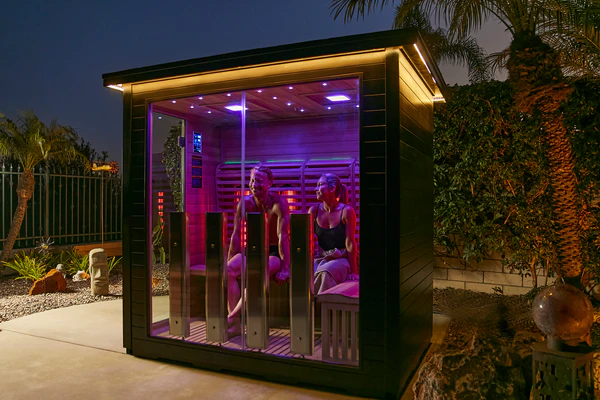
Sun Home Saunas uses cedar and basswood for their versatility and broad suitability
Basswood
Basswood, also known as American Linden, is known for its softness, lightness, and fine grain, basswood is easy to carve and shape. This makes it a favorite among woodworkers for crafting detailed items. Its smooth texture and lightweight nature make it a practical choice for more intricate sauna designs.
Durability: When cut thick enough (¾” or thicker), basswood adds significant durability to sauna cabinets. Its stability in the fluctuating sauna temperatures ensures longevity. Being non-odorous and non-toxic, basswood is a safe choice for home saunas, avoiding overwhelming scents and allergic reactions.
Sustainability: Basswood grows quickly, maturing in just seven years, making it an eco-friendly option. Its rapid replenishment and sustainable nature make it an environmentally responsible choice for sauna construction. Basswood's hypoallergenic and non-toxic qualities further enrich its appeal for a comfortable, safe, sauna experience.
Thermodynamics: Basswood is a natural hardwood and has a light color, making saunas feel more spacious and inviting. Although it may not be as well known for thermal insulation as softwood, its light shade can have a positive impact on the ambiance and comfort of the sauna.
Odorless Nature: Basswood is notable for its lack of odor, even when worked with. This property makes it ideal for people sensitive to strong odors or in areas where a neutral odor is preferred. The odorless nature provides a non-intrusive sauna experience, suitable for those looking for an odor-free environment.
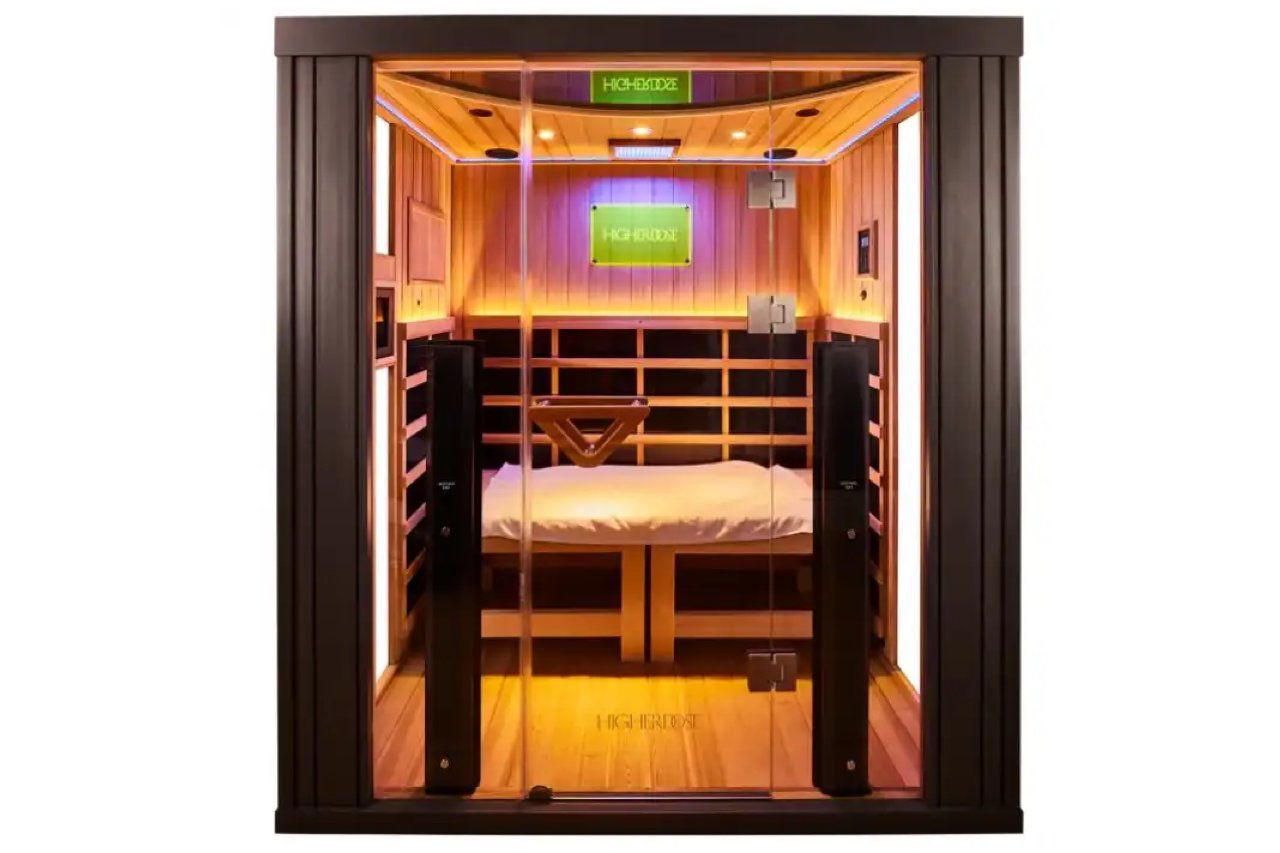
The HigherDOSE infrared sauna features a sleek Black Mahogany exterior and Basswood interior
Cedar
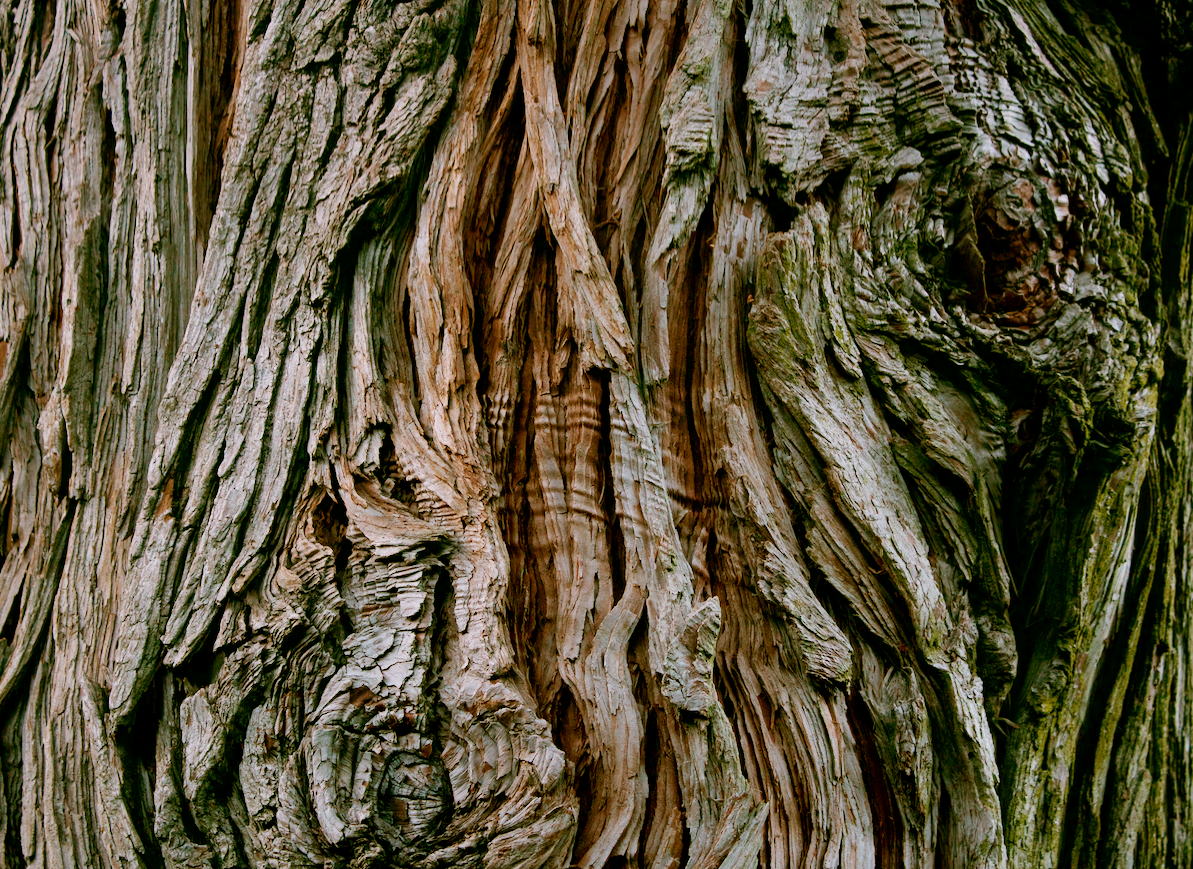
Cedar is a premier choice for saunas because it’s enduring and resistant to heat and moisture. Its natural properties make it ideal for the high-temperature and humidity levels in saunas. Cedar doesn't secrete resin or overheat either, perfect for interior panels and benches. Its varieties, like Western Red Cedar and Eastern Red Cedar, both are prized for their quality and performance in sauna construction.
Durability: Cedar resists cracking and splitting caused by heat cycles in saunas. It's naturally resistant to decay, insects, and moisture, and therefore long-lasting. It retains its shape and functionality over time, and doesn't warp or shrink notably.
Sustainability: Especially Western Red Cedar is widely recognized as a sustainable and eco-friendly wood. Sourced from regenerating forests, it supports biodiversity and wildlife habitats. It's biodegradable, recyclable, and helps reduce greenhouse gases, making it a responsible choice. Harvested from certified, sustainably managed forests, it has a lighter carbon footprint due to its lightweight nature.
Thermodynamics: Cedar is a softwood that warms quickly, achieving ideal sauna temperatures while remaining comfortable to touch. Featuring excellent insulation and energy efficiency, it is also an eco-friendly material.
Aroma: The pleasant aroma of cedar wood creates a relaxing atmosphere. The oils spread a soothing scent, improve your sauna experience through aromatherapy and draw you into a state of unwinding and well-being. Inhaling cedarwood aroma can have antiseptic and anti-inflammatory effects. This helps with respiratory problems, skin conditions and as a bonus, insects don’t like it one bit. Cedars' natural compounds evoke a calming environment conducive to stress relief and meditation.
Types of Cedar
Each cedar type has slightly different aromatic compounds, influencing their therapeutic properties and sensory experience.
- Western Red Cedar is known for its distinct aroma and often used in saunas for its calming effect and association with the outdoors.
- Eastern White Cedar has a typically milder scent, described as sweet and subtle.
- Atlas Cedarwood (Cedrus Atlantica) is used in essential oils for its balsamic and woody aroma, thought to be grounding and comforting.
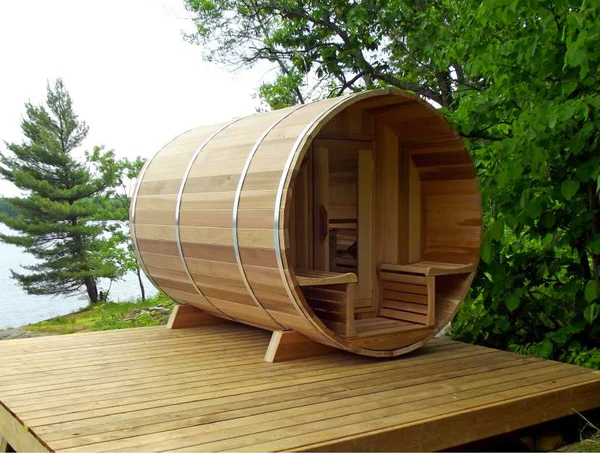
Sun Home Saunas - Canadian Cedar Barrel Sauna
Eucalyptus
Eucalyptus is a versatile and aromatic wood, celebrated for its fast growth and healing properties. Its leaves, oil, and wood are used in many applications, from construction to medicinal teas. In saunas, eucalyptus brings a unique blend of therapeutic benefits and excellent performance, making it a compelling choice for those seeking a refreshing and health-promoting sauna experience.
Durability: Eucalyptus wood is highly sustainable, regenerating quickly and effectively sequestering carbon. It's adaptable and promotes ecological balance, with a long life that ensures prolonged carbon storage.
Sustainability: The transportation and end-of-life stages of eucalyptus are environmentally conscious when sourced locally and upcycled, or used as bioenergy, reducing its overall carbon footprint.
Thermodynamics: Eucalyptus's rapid growth and density contribute to its durability and thermal properties, making it suitable for the varying temperatures in saunas.
Aroma: When heated in a sauna, eucalyptus releases a refreshing aroma that gives respiratory relief, heightens mental clarity, and boasts antimicrobial effects. All this adds to the therapeutic experience.
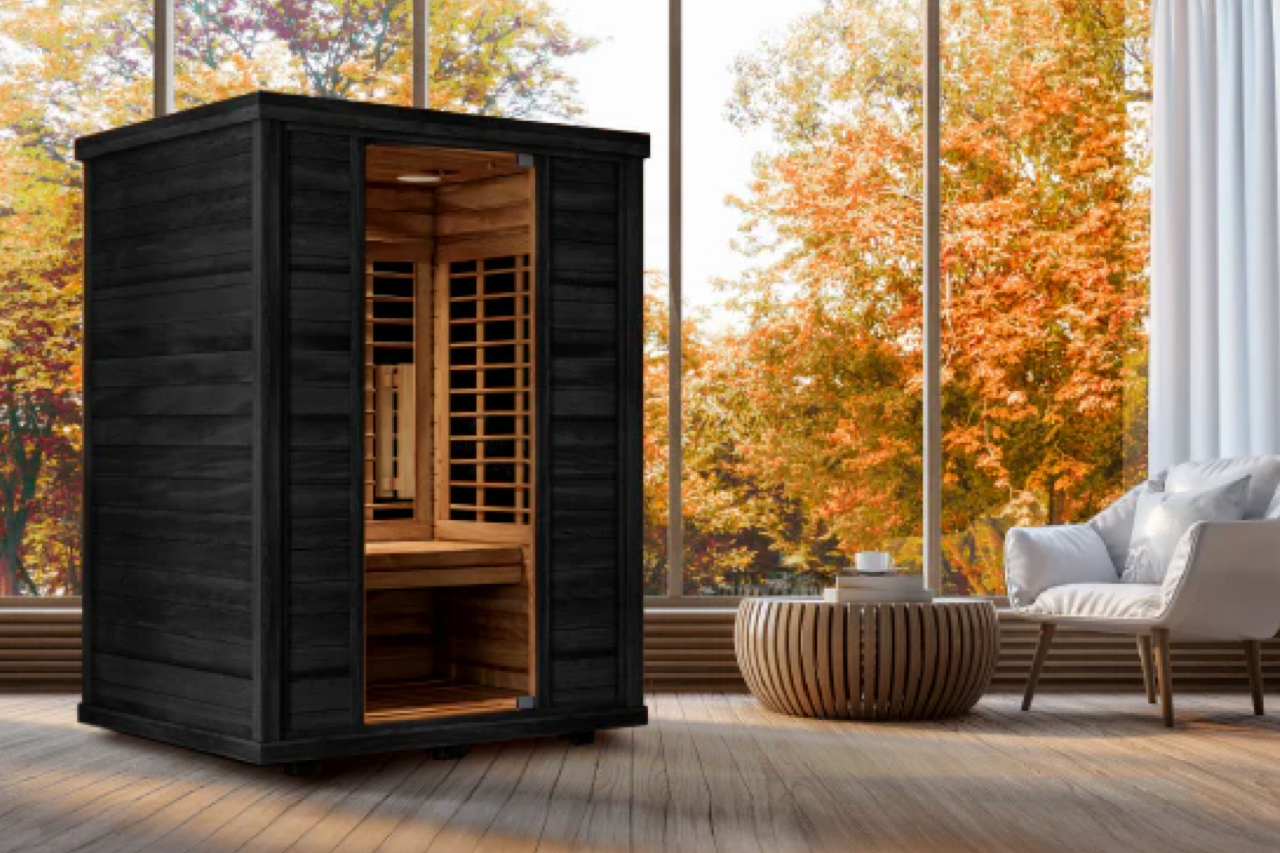
Hemlock
Any listing of the best wood for infrared sauna rooms, would be incomplete without hemlock. Scientifically referred to as Tsuga, it's a distinguished wood known for its robustness, serene beauty, and gentle aroma. Mainly found in the cool, moist regions of North America and parts of Asia, hemlock has a wide natural range that contributes to its accessibility and sustainable use. It's a wood that brings physical strength and stability plus a touch of nature’s tranquility into the sauna environment.
Durability: Hemlock wood is favored for infrared sauna construction due to its robust physical properties and performance under the demanding conditions typical in saunas. It's known for its superior scratch resistance, which is essential for maintaining the aesthetic and functional quality of sauna interiors. The wood demonstrates exceptional compressive and bending strength. This ensures it maintains its structural integrity even under the fluctuating temperatures and humidity levels in saunas. While not as resistant as cedar, hemlock still offers a degree of protection against decay and insects.
Sustainability: Because hemlock is often sourced from forests managed for sustainability, its use does not lead to deforestation or habitat loss.
Thermodynamics: As a dense wood, hemlock retains heat well, and this natural efficiency reinforces a stable and consistent sauna space.
Aroma: Hemlock has a neutral scent and keeps your sauna surroundings pleasant without overwhelming the senses. This is especially suitable if you’re sensitive to strong odors. The subtle scent complements a calming and meditative space, great if you prefer a less intense scented experience.
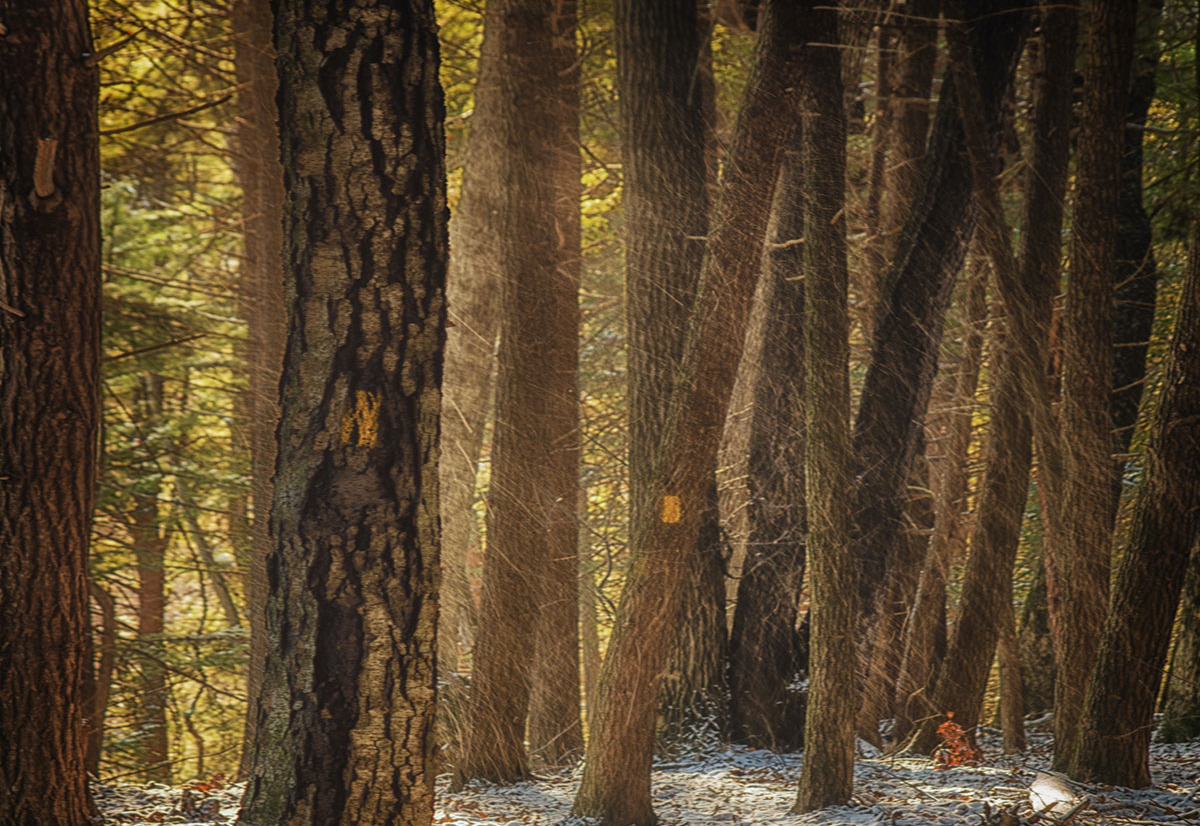
Types of Hemlock
Canadian Hemlock (Eastern Hemlock):
These trees thrive in the boreal forests of North America and adapt to a wide range of environments. This versatility makes Canadian Hemlock wood a reliable material for saunas. The light hue and fine grain of Canadian Hemlock wood make for visually appealing spaces, imbued with a sense of stillness. This wood boasts outstanding dimensional stability and resists distortion under the temperature changes and moistness of saunas.
Although it shares certain characteristics with its Western counterpart, the Canadian Hemlock is distinguished by its unique appearance and sturdiness, and adds a sense of serenity and a touch of wilderness to your sauna enjoyment.
Western Hemlock:
This species holds sway over the vast forests of the Pacific Northwest, ranging from the chilly climes of Alaska down to the varied landscapes of California. Western Hemlock is celebrated for its impressive stature and the premium quality of its timber, and is able to thrive in a broad spectrum of soils and climatic conditions.
Within the context of infrared saunas, Western Hemlock assures durability alongside a refined grain texture. It doesn’t easily warp or, and upholds its structural integrity amid the sauna's heat and wetness. Western Hemlock has a distinctive aroma and a superior quality, offering a unique, peaceful, sauna experience that sets it apart from its Eastern relative.

Don’t want to skip your sauna while traveling? Try the HigherDose Sauna Blanket
Spruce
Spruce, also known as Finnish white pine, is a classic choice in sauna building and is particularly prized in the Scandinavian countries for its rustic charm and vigor. It is durable and stable due to tight growth rings and uniform texture. With its light color and pleasant scent when heated, spruce wood contributes to the traditional sauna atmosphere. Spruce is a cost-effective, environmentally friendly choice for sauna enthusiasts.
Durability: While typically durable, its performance in the less intense heat of infrared saunas may differ, requiring specific maintenance considerations. It's cost-effective and provides good thermal insulation. However, it may not be as durable as other woods like cedar or hemlock and can be prone to warping and cracking over time.
Sustainability: Like many natural woods used in saunas, it's harvested and produced with sustainability in mind.
Thermodynamics: Spruce's dense nature and traditional use in saunas offer good thermal properties for infrared settings. Spruce's insulation is effective at maintaining a comfortable heat, with thermal modification further improving its stability and resistance to the unique heating method.
Aroma: When heated, spruce emits a natural wood scent, contributing to the sauna experience. This subtle scent enhances the sauna experience, providing a natural, therapeutic aroma without overpowering, making it a preferred choice for a relaxing environment.

Choosing the Right Wood for Your Needs
When deciding on the best wood for your infrared sauna, several factors come into play, especially for home use. The right choice balances aesthetics, functionality, sustainability, health benefits, and maintenance needs.
Whether you're considering a pre-built cabin or a DIY project, understanding these elements will guide you to make an informed decision.
Space Requirements and Installation
Pre-built Cabins: If space is limited or you prefer a straightforward setup, pre-built cabins might be the way to go. Manufacturers typically select the wood, so understanding the properties of commonly used types is important. Select wood that aligns with your needs and preferences.
DIY Projects: For those with specific requirements or a penchant for customization, building your sauna gives you greater flexibility. You can select the wood type that best suits your space, aesthetic, and health considerations. However, this option requires a clear understanding of the wood's properties and how they interact with infrared sauna technology.
Aesthetics and Ambiance
The wood you choose significantly influences the look and feel of your sauna. Each type has its unique color, grain, and texture, contributing to the overall ambiance of your relaxation space.
Woods like Cedar and Hemlock offer rich, warm tones that can make a sauna feel cozy and inviting. Aspen and Basswood provide lighter shades, creating a serene and spacious feel.
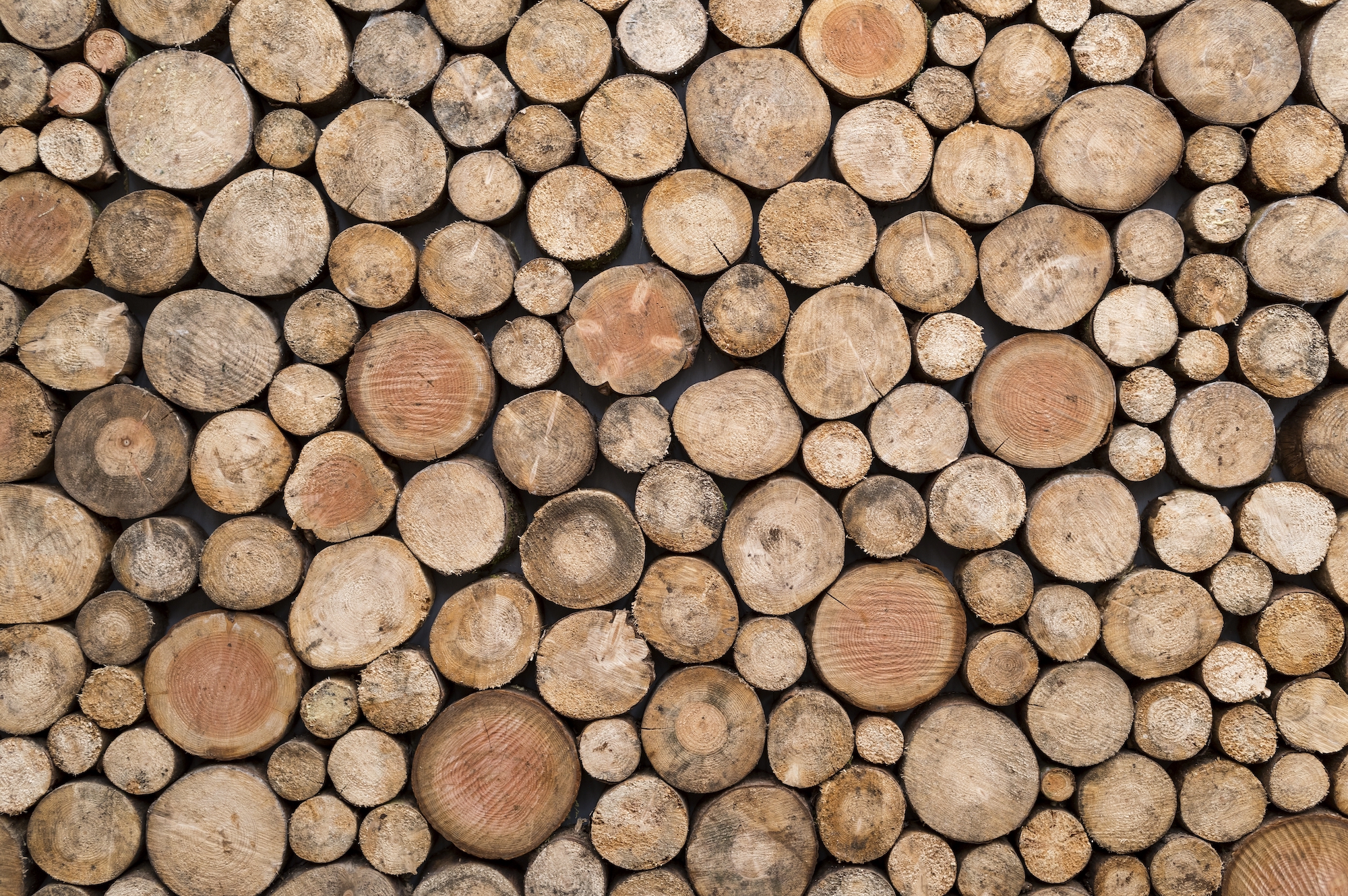
Sustainability
Check certifications to see whether the wood you choose meets the environmental friendliness requirements. These are the three most common: Forest Stewardship Council (FSC) [2], Programme for the Endorsement of Forest Certification (PEFC) [3] and Sustainable Forestry Initiative (SFI) [4].
Health Benefits
The type of wood can impact the health benefits your sauna provides. With the concept of phytoncides and the wood's natural properties, your choice can complement the therapeutic experience. Woods like cedar and eucalyptus emit natural oils that can aid in relaxation and respiratory health.
For those with sensitivities, hypoallergenic woods like basswood is an excellent choice.
Longevity and Maintenance
The durability and maintenance needs of the wood are critical, especially for long-term satisfaction and ease of use. Wood varies in its resistance to moisture, heat and insects. If you choose sustainable wood such as cedar or hemlock, your sauna will stand the test of time.
Take into account the maintenance requirements per type of wood. For general maintenance tips, read our article '10 Essential Infrared Sauna Maintenance Tips'.
Consider the above factors to make sure your sauna meets your requirements and becomes a cherished, and durable, addition to your home.
Did you find this guide helpful? If you’re interested in more tips on sauna accessories, maintenance, and wellness gear like sauna blankets and PEMF mats, be sure to visit saunace.com and explore our blog. We’re here to help you create the perfect at-home relaxation and recovery space.
Saunace is supported by its audience. When you purchase through links on our website, we may earn an affiliate commission. Learn more.

Diane Sargent
Check out these blogposts below
References
1. New York State, Immerse Yourself In A Forest For Better Health, Department of Environmental Conservation, https://dec.ny.gov/nature/forests-trees/immerse-yourself-for-better-health
2. Forest Stewardship Council, The Future of Forests is in Our Hands, https://fsc.org/en
3. Programme for the Endorsement of Forest Certification, PEFC - your partner for the EUDR, https://www.pefc.org/
4. Sustainable Forestry Initiative, https://forests.org/
